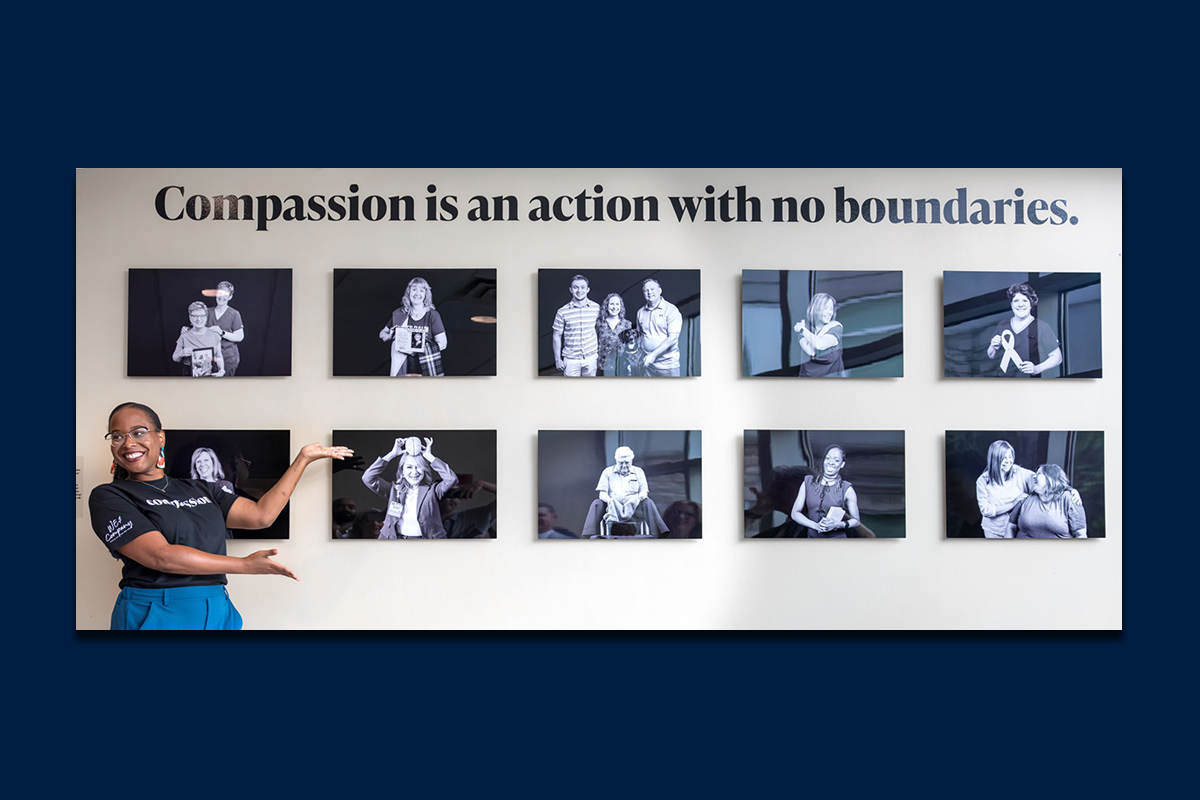Compassion on display at Penn State Health St. Joseph Medical Center

When Jeannette Reigel first started volunteering at Penn State Health St. Joseph Medical Center three years ago, she passed her moments of free time between tasks by twisting brown paper bags to create small tree sculptures, which she then gave away to patients, visitors and staff. Today, a photo of Reigel holding one of her paper trees is among four dozen “Compassion Project” portraits displayed throughout the hospital.
The Compassion Project is an interactive photography installation that honors St. Joseph Medical Center’s staff and volunteers—collectively the embodiment of compassion. Each participant was encouraged to bring someone or something to the photo shoot that signified compassion to them. For Reigel, it was her paper trees that she makes to give to others. For Chelsea Robins, a nurse in the Cardiac Catheterization Lab, it was her guitar.
“My guitar centers me,” Robins said in the interactive portion of the exhibit, which features audio recordings of the participants explaining what compassion means to them and why they chose their items or people for their photographs. Music relaxes her, she explained, and keeps her grounded outside of her role as a nurse. “It’s helped me not get burned out, so I can give everything when I’m at the hospital.”
Patients and visitors at St. Joseph Medical Center can take part in the Compassion Project by scanning QR codes near the photos. The codes lead to a website where they can hear the participants’ reflections and see more photos.
Driven to care
“Compassion is the driving force behind our care, guiding us to treat each and every patient with kindness, dignity and respect,” said Joseph Frank, president of Penn State Health Lancaster and St. Joseph medical centers. “It’s a word I so often read in letters from thankful patients. And now seeing these photos and listening to the incredibly powerful reflections on compassion, I’m struck by the legacy we have here, how patients, visitors and staff alike can see and hear how the values rooted in over 150 years of Franciscan tradition live in our staff and volunteers.”
Several participants brought Bibles with them, while many others brought their loved ones. Some brought unexpected items, like a rolling pin, a Scottish tartan or a walking stick. Joyce Martin, a chaplain in the hospital’s Cancer Center, brought a photo of her goats.
“They give us lots of joy,” she said, adding that compassion means showing “somebody is willing to step in, to listen, to ease the burden that so many of us carry.”
Christina Kershner, a radiation oncology nurse, chose to be photographed holding a “cover”—the military term for a hat—that one of her patients who had served in the Marines had given her.
“I was so honored to receive his gift,” Kershner said, explaining the patient’s wife told her that despite many friends and relatives asking him for one of his covers over the years, this was the first one he’d ever given away.
Shortly before her photo session for The Compassion Project, Kershner learned that the former Marine had entered hospice care at a Veterans Affairs facility. His wife told her that he didn’t want visitors. A few days later, he changed his mind. He welcomed Kershner, who brought him a treasured angel pin.
“Compassion is having the desire to help people in their time of need,” she said. “Compassion is helping people who are suffering. Not because we pity them but because we truly have a calling to do so. It’s what completes us as individuals.”
The Compassion Project, photographed and curated by Shelby and Jordan Wormley, co-founders of WE&Company, was funded through philanthropic dollars. Plans are to rotate the artwork periodically to showcase different stories of compassion.
If you're having trouble accessing this content, or would like it in another format, please email Penn State Health Marketing & Communications.
